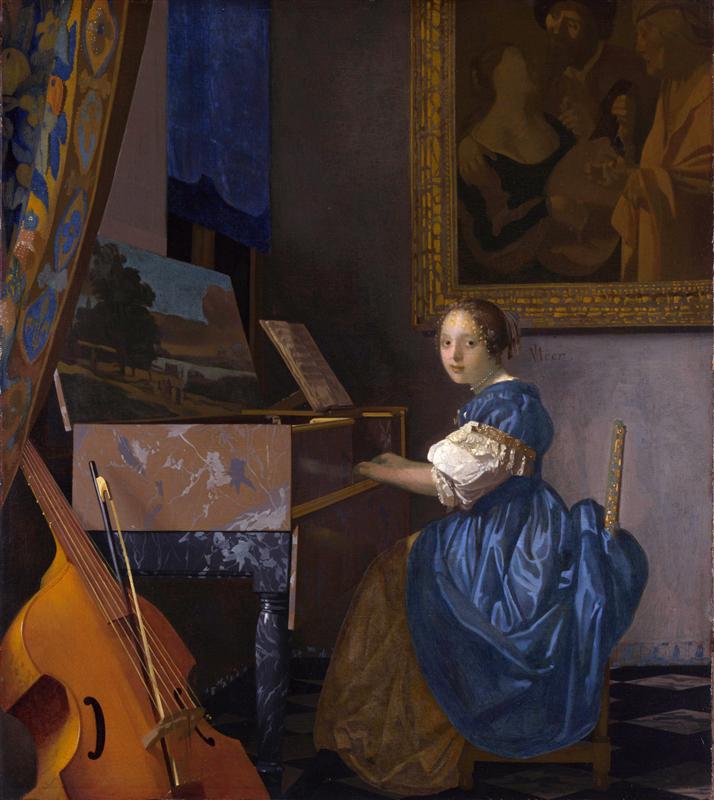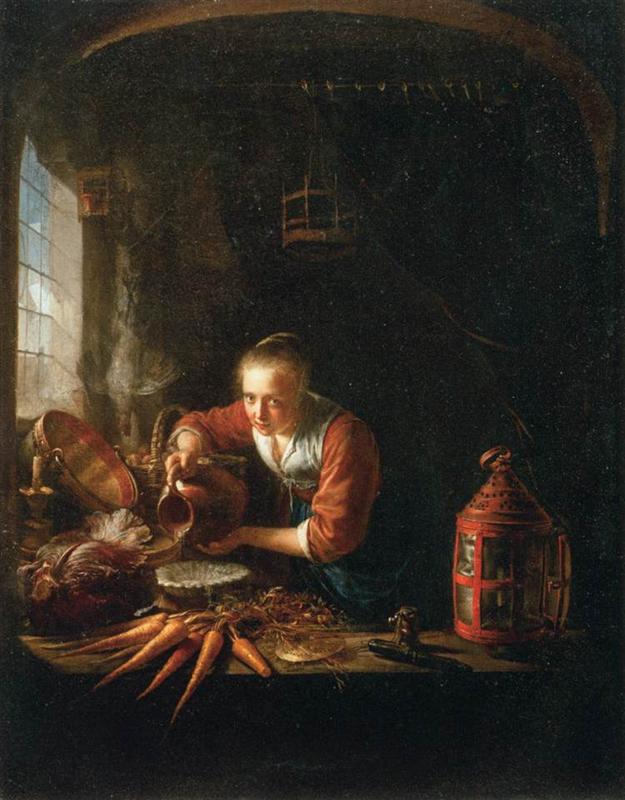February 20 through May 22, 2017
National Gallery of Ireland
June 17 through September 17, 2017
The
Musée du Louvre, in collaboration with the National Gallery of Ireland
in Dublin and the National Gallery of Art in Washington, is holding a
landmark exhibition about renowned painter Johannes Vermeer. For the
first time since 1966, this event will bring together twelve of the
Delft master’s paintings—a third of his total known body of
work—providing an insight into the fascinating relationships the artist
maintained with other great painters of the Dutch Golden Age.
Thanks to special loans from the most prominent American, British, German, and—naturally—Dutch museums, visitors will be able to see Vermeer in a new light.
The exhibition does away with the legend of the reclusive artist living in his own inaccessible, silent world—without ever implying that Vermeer was just one painter of many. Indeed, his artistic temperament grew more distinct through encounters with other artists. Vermeer did more than launch a new movement: he acted as an agent of metamorphosis.
Thanks to special loans from the most prominent American, British, German, and—naturally—Dutch museums, visitors will be able to see Vermeer in a new light.
The exhibition does away with the legend of the reclusive artist living in his own inaccessible, silent world—without ever implying that Vermeer was just one painter of many. Indeed, his artistic temperament grew more distinct through encounters with other artists. Vermeer did more than launch a new movement: he acted as an agent of metamorphosis.
“The
Sphinx of Delft”: coined by French journalist and art critic Théophile
Thoré-Bürger when he revealed Vermeer to the world late in the 19th
century, this famous expression has served mainly to promote an
enigmatic image of the painter. The myth of the solitary genius has done
the rest. Yet Johannes Vermeer (1632–1675) did not attain his level of
creative mastery in isolation from the art of his time.
Through comparisons with the works of other artists of the Golden Age—among them Gerrit Dou, Gerard ter Borch, Jan Steen, Pieter de Hooch, Gabriel Metsu, Caspar Netscher, and Frans van Mieris—the exhibition brings to light Vermeer’s membership of a network of painters specializing in the depiction of everyday life while admiring, inspiring, and vying with each other.
The third quarter of the 17th century saw the Dutch Republic’s global economic power reach its apogee. Proud of their social standing, the Dutch elite demanded art that would reflect their prestige. This demand led to the emergence of a “new wave” of genre painting in the early 1650s, with artists shifting their focus to idealized depictions of domesticity in elegant society. The men and women portrayed in these masterfully-executed pieces display a staged civility.
Although the artists in question worked in different cities across the Republic of the United Netherlands, their technique, and the style, subjects, and compositions featured in their work showed considerable similarities. The exceptional quality of their creations can be partly attributed to the lively professional rivalry that existed between them.
A Young Woman Seated at a Virginal by Johannes Vermeer
and Woman Feeding a Parrot by Frans van Mieris the Elder
Through comparisons with the works of other artists of the Golden Age—among them Gerrit Dou, Gerard ter Borch, Jan Steen, Pieter de Hooch, Gabriel Metsu, Caspar Netscher, and Frans van Mieris—the exhibition brings to light Vermeer’s membership of a network of painters specializing in the depiction of everyday life while admiring, inspiring, and vying with each other.
The third quarter of the 17th century saw the Dutch Republic’s global economic power reach its apogee. Proud of their social standing, the Dutch elite demanded art that would reflect their prestige. This demand led to the emergence of a “new wave” of genre painting in the early 1650s, with artists shifting their focus to idealized depictions of domesticity in elegant society. The men and women portrayed in these masterfully-executed pieces display a staged civility.
Although the artists in question worked in different cities across the Republic of the United Netherlands, their technique, and the style, subjects, and compositions featured in their work showed considerable similarities. The exceptional quality of their creations can be partly attributed to the lively professional rivalry that existed between them.
A Young Woman Seated at a Virginal by Johannes Vermeer
and Woman Feeding a Parrot by Frans van Mieris the Elder
Exhibition curators:
Blaise Ducos, Department of Paintings, Musée du Louvre, Paris, Adriaan
E. Waiboer, National Gallery of Ireland, Dublin, and Arthur K. Wheelock
Jr., National Gallery of Art, Washington
-
De Hooch
Woman with a balance
(c)BPK, Berlin, Dist. RMN-Grand Palais / Jörg P.Anders
-
Vermeer
Woman with a Balance
(c)Washington, National Gallery of Art
-
Metsu
A Man Writing a Letter
(c)Dublin, National Gallery of Ireland
-
Metsu
A woman reading a letter
(c)Dublin, National Gallery of Ireland
-
Vermeer
A Lady Writing a Letter, with her Maid
(c)Dublin, National Gallery of Ireland -
Vermee
A Lady Writing
(c)Washington, National Gallery of Art
-
Ter Borch
A Woman at a Mirror
(c)Amsterdam, The Rijksmuseum
-
Van Mieris
A Woman examining Herself in a Mirror
(c)BPK, Berlin, Dist. RMN-Grand Palais / Jörg P. Anders
-
Vermeer
Young Woman with Pearls
(c)BPK, Berlin, Dist. RMN-Grand Palais Jörg P. Ander
-
Netscher
A Woman Feeding a Parrot with a Page
(c)Washington, National Gallery of Art
-
Van Mieris
The Duet
(c)BPK, Berlin, Dist. RMN-Grand Palais /image Staatliches Museum Schwerin
-
Vermeer
A woman sitting at a Virginal
(c)National Gallery, London
-
Van Hoogstraten
The Slippers
(c)RMN-Grand Palais (musée du Louvre) / Tony Querrec
-
Steen
A Woman at her Toilet
(c)Royal Collection Trust/ Her Majesty Queen Elizabeth II 2016
-
De Hooch
A Woman Nursing an Infant with a Child and a Dog
(c)Fine Arts Museums of San Francisco
-
Dou
Astronomer by Candlelight
(c)Los Angeles, J. Paul Getty Museum
-
Vermee
The Astronomer
(c)RMN-Grand Palais (musée du Louvre) / Franck Raux
Dou
A kitchen Maid pourring water into a jar
(c)RMN-Grand Palais (Musée du Louvre) / Tony Querrec
-
Vermeer
The Milkmaid
(c)Amsterdam, The Rijksmuseum
-
Maes
A Young Woman sewing
(c)Guildhall Art Gallery, City of London / Harold Samuel Collection / Bridgeman Images
-
Vermeer
The Lace Maker
(c)RMN-Grand Palais (musée du Louvre) / Gérard Blot
-
Ter Borch
Galant Conversation-The Paternal Admonition
(c)Amsterdam, The Rijksmuseum
-
Vermeer
The Allegory of the Catholic Faith
(c)The Metropolitan Museum of Art, Dist. RMN-Grand Palais / image of the MMA

























